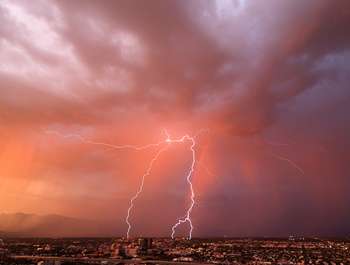Scientists at the University at Albany and the University of California-Berkeley are expecting a significant increase in lightning strikes during the 21st century.
A new study published in Science predicts a 50 percent increase in lightning strikes across the United States during this century as a result of warming temperatures associated with climate change.
University at Albany Professor of Atmospheric and Environmental Sciences John Molinari and Senior Scientific Programmer David Vollaro in conjunction with UC Berkeley climate scientist David Romps and graduate student Jacob Seeley looked at predictions of precipitation and cloud buoyancy in 11 different climate models and concluded that their combined effect will generate more frequent electrical discharges to the ground.
"With warming, thunderstorms become more explosive," said Romps, an assistant professor of earth and planetary science and a faculty scientist at Lawrence Berkeley National Laboratory, and lead author of the study. "This has to do with water vapor, which is the fuel for explosive deep convection in the atmosphere. Warming causes there to be more water vapor in the atmosphere, and if you have more fuel lying around, when you get ignition, it can go big time."
A significant impact of increased lightning strikes would be more wildfires, since half of all fires—and often the hardest to fight—are ignited by lightning, Romps said. More lightning also would likely generate more nitrogen oxides in the atmosphere, which exert a strong control on atmospheric chemistry, and could result more human injuries: estimates of people struck each year range from the hundreds to nearly a thousand, with scores of deaths.
The study made use of U.S. Weather Service data on precipitation, radiosonde measurements of temperature and moisture, and lightning-strike counts from the National Lightning Detection Network. The lightning network was developed at the University at Albany during the 1980s. It measures the location of cloud-to-ground lightning flashes in the United States and out to a few hundred miles offshore with great accuracy. Data from the network has previously been used to study the behavior of hurricanes.
"This paper represents the first time we have used these data for climate-related problems," said Molinari. "Our approach was to use the relationship of lightning to 'convective available potential energy' (CAPE; a measure of the potential for thunderstorms) and precipitation in the current climate. Then we used that knowledge to estimate the potential for increased lightning in future climates, evaluated from climate model predictions."
The team looked at 11 different climate models that predict precipitation and CAPE through this century and are archived in the most recent Coupled Model Intercomparison Project (CMIP5). CMIP was established as a resource for climate scientists, providing a repository of output from global climate models that can be used for comparison and validation.
"With CMIP5, we now have for the first time the CAPE and precipitation data to calculate these time series," Romps said.
On average, the models predicted an 11 percent increase in CAPE in the U.S. per degree Celsius rise in global average temperature by the end of the 21st century. Since the models predict little average precipitation increase nationwide over this period, the product of CAPE and precipitation gives about a 12 percent rise in cloud-to-ground lightning strikes per degree in the contiguous U.S., or a roughly 50 percent increase by 2100 if Earth sees the expected 4-degree Celsius increase (7° F) in temperature. This assumes carbon dioxide emissions keep rising consistent with current trends.
Exactly why CAPE increases as the climate warms is still an area of active research, Romps said, though it is clear that it has to do with the fundamental physics of water.
Journal information: Science
Provided by University at Albany






















